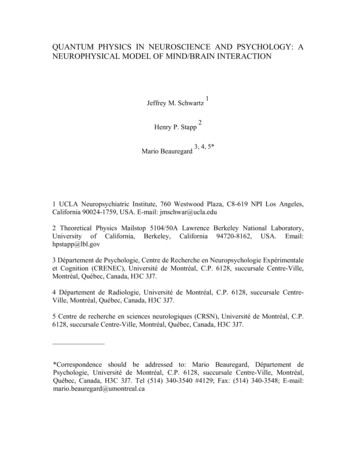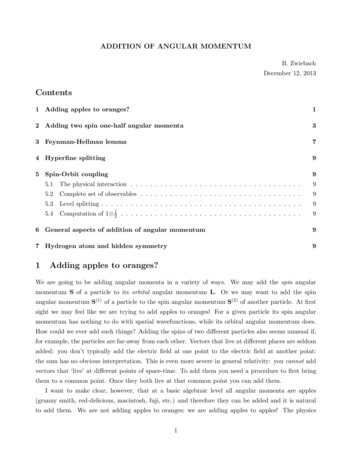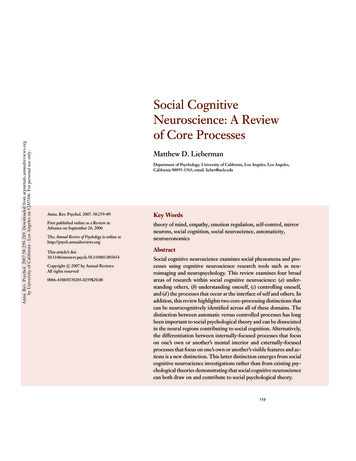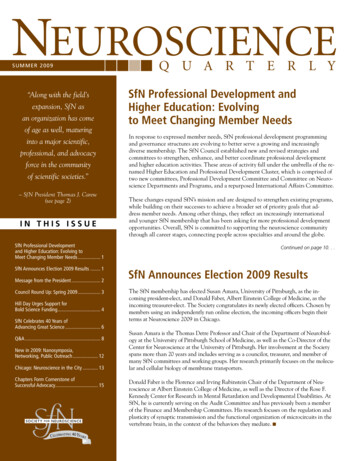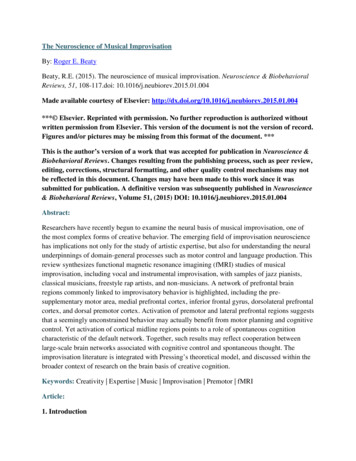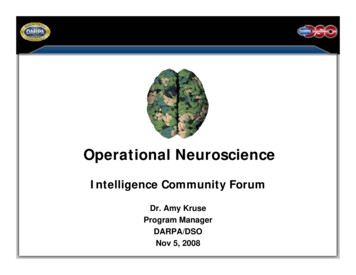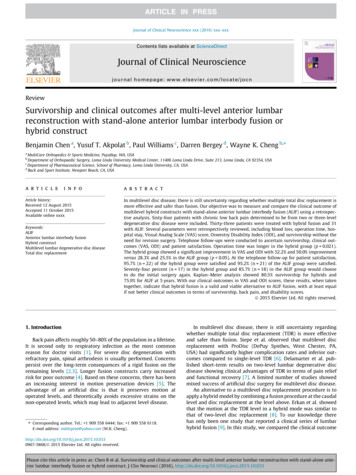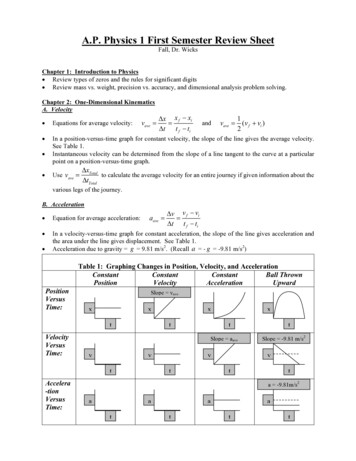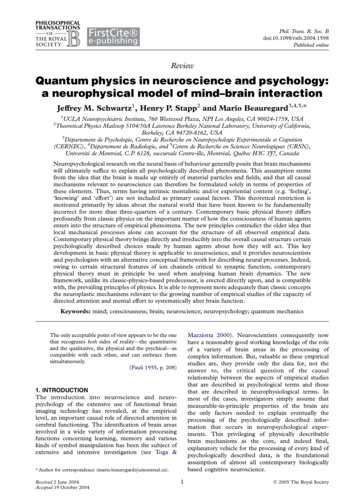
Transcription
Phil. Trans. R. Soc. Bdoi:10.1098/rstb.2004.1598Published onlineReviewQuantum physics in neuroscience and psychology:a neurophysical model of mind–brain interactionJeffrey M. Schwartz1, Henry P. Stapp2 and Mario Beauregard3,4,5,*1UCLA Neuropsychiatric Institute, 760 Westwood Plaza, NPI Los Angeles, CA 90024-1759, USATheoretical Physics Mailstop 5104/50A Lawrence Berkeley National Laboratory, University of California,Berkeley, CA 94720-8162, USA3Département de Psychologie, Centre de Recherche en Neuropsychologie Expérimentale et Cognition(CERNEC), 4Département de Radiologie, and 5Centre de Recherche en Sciences Neurologiques (CRSN),Université de Montréal, C.P. 6128, succursale Centre-ille, Montréal, Québec H3C 3J7, Canada2Neuropsychological research on the neural basis of behaviour generally posits that brain mechanismswill ultimately suffice to explain all psychologically described phenomena. This assumption stemsfrom the idea that the brain is made up entirely of material particles and fields, and that all causalmechanisms relevant to neuroscience can therefore be formulated solely in terms of properties ofthese elements. Thus, terms having intrinsic mentalistic and/or experiential content (e.g. ‘feeling’,‘knowing’ and ‘effort’) are not included as primary causal factors. This theoretical restriction ismotivated primarily by ideas about the natural world that have been known to be fundamentallyincorrect for more than three-quarters of a century. Contemporary basic physical theory differsprofoundly from classic physics on the important matter of how the consciousness of human agentsenters into the structure of empirical phenomena. The new principles contradict the older idea thatlocal mechanical processes alone can account for the structure of all observed empirical data.Contemporary physical theory brings directly and irreducibly into the overall causal structure certainpsychologically described choices made by human agents about how they will act. This keydevelopment in basic physical theory is applicable to neuroscience, and it provides neuroscientistsand psychologists with an alternative conceptual framework for describing neural processes. Indeed,owing to certain structural features of ion channels critical to synaptic function, contemporaryphysical theory must in principle be used when analysing human brain dynamics. The newframework, unlike its classic-physics-based predecessor, is erected directly upon, and is compatiblewith, the prevailing principles of physics. It is able to represent more adequately than classic conceptsthe neuroplastic mechanisms relevant to the growing number of empirical studies of the capacity ofdirected attention and mental effort to systematically alter brain function.Keywords: mind; consciousness; brain; neuroscience; neuropsychology; quantum mechanicsMazziotta 2000). Neuroscientists consequently nowhave a reasonably good working knowledge of the roleof a variety of brain areas in the processing ofcomplex information. But, valuable as these empiricalstudies are, they provide only the data for, not theanswer to, the critical question of the causalrelationship between the aspects of empirical studiesthat are described in psychological terms and thosethat are described in neurophysiological terms. Inmost of the cases, investigators simply assume thatmeasurable-in-principle properties of the brain arethe only factors needed to explain eventually theprocessing of the psychologically described information that occurs in neuropsychological experiments. This privileging of physically describablebrain mechanisms as the core, and indeed final,explanatory vehicle for the processing of every kind ofpsychologically described data, is the foundationalassumption of almost all contemporary biologicallybased cognitive neuroscience.The only acceptable point of view appears to be the onethat recognizes both sides of reality—the quantitativeand the qualitative, the physical and the psychical—ascompatible with each other, and can embrace themsimultaneously.(Pauli 1955, p. 208)1. INTRODUCTIONThe introduction into neuroscience and neuropsychology of the extensive use of functional brainimaging technology has revealed, at the empiricallevel, an important causal role of directed attention incerebral functioning. The identification of brain areasinvolved in a wide variety of information processingfunctions concerning learning, memory and variouskinds of symbol manipulation has been the subject ofextensive and intensive investigation (see Toga &* Author for correspondence (mario.beauregard@umontreal.ca).Received 2 June 2004Accepted 19 October 20041q 2005 The Royal Society
2J. M. Schwartz and others Model of mind–brain interactionIt is becoming increasingly clear, however, that thereis at least one type of information processing andmanipulation that does not readily lend itself toexplanations that assume that all final causes aresubsumed within brain, or more generally, centralnervous system mechanisms. The cases in question arethose in which the conscious act of wilfully altering themode by which experiential information is processeditself changes, in systematic ways, the cerebral mechanisms used. There is a growing recognition of thetheoretical importance of applying experimental paradigms that use directed mental effort to producesystematic and predictable changes in brain function(e.g. Beauregard et al. 2001; Ochsner et al. 2002).These wilfully induced brain changes are generallyaccomplished through training in, and the applied useof, cognitive reattribution and the attentional recontextualization of conscious experience. Furthermore, an accelerating number of studies in theneuroimaging literature significantly support the thesisthat, again, with appropriate training and effort, peoplecan systematically alter neural circuitry associated witha variety of mental and physical states that are franklypathological (Schwartz et al. 1996; Schwartz 1998;Musso et al. 1999; Paquette et al. 2003). A recentreview of this and the related neurological literature hascoined the term ‘self-directed neuroplasticity’ to serveas a general description of the principle that focusedtraining and effort can systematically alter cerebralfunction in a predictable and potentially therapeuticmanner (Schwartz & Begley 2002).From a theoretical perspective, perhaps the mostimportant aspect of this line of research is the empiricalsupport it provides for a new science-based way ofconceptualizing the interface between mind/consciousness and brain. Until recently, virtually all attempts tounderstand the functional activity of the brain havebeen based, at least implicitly, on some principles ofclassic physics that have been known to be fundamentally false for three-quarters of a century. According tothe classic conception of the world, all causal connections between observables are explainable in terms ofmechanical interactions between material realities. Butthis restriction on modes of causation is not fullymaintained by the currently applied principles ofphysics, which consequently offer an alternative conceptual foundation for the scientific description andmodelling of the causal structure of self-directedneuroplasticity.The advantages for neuroscience and neuropsychology of using the conceptual framework ofcontemporary physics, as opposed to that of classicphysics, stem from five basic facts. First, terms suchas ‘feeling’, ‘knowing’ and ‘effort’, because they areintrinsically mentalistic and experiential, cannot bedescribed exclusively in terms of material structure.Second, to explain the observable properties of largephysical systems that depend sensitively upon thebehaviours of their atomic constituents, the foundersof contemporary physical theory were led to introduceexplicitly into the basic causal structure of physics certainimportant choices made by human beings about howthey will act. Third, within this altered conceptualframework these choices are described in mentalisticPhil. Trans. R. Soc. B(i.e. psychological) language. Fourth, terminology ofprecisely this kind is critically necessary for the designand execution of the experiments in which the datademonstrating the core phenomena of self-directedneuroplasticity are acquired and described. Fifth, theinjection of psychologically described choices on thepart of human agents into the causal theoreticalstructure can be achieved for experiments in neuroscience by applying the same mathematical rules thatwere developed to account for the structure ofphenomena in the realm of atomic science.The consequence of these facts is that twentiethcentury physics, in contrast to classic physics, provides arationally coherent pragmatic framework in which thepsychologically and neurophysiologically describedaspects of the neuroscience experiments mentionedabove are causally related to each other in mathematically specified ways. Thus, contemporary physicsallows the data from the rapidly emerging field of selfdirected neuroplasticity to be described and understoodin a way that is more rationally coherent, scientific anduseful than what is permitted by theories in which allcausation is required to be fundamentally mechanical.To explicate the physics of the interface betweenmind/consciousness and the physical brain, we shall inthis article describe in detail how the quantummechanically based causal mechanisms work, andshow why it is necessary in principle to advance tothe quantum level to achieve an adequate theory of theneurophysiology of volitionally directed activity. Thereason, essentially, is that classic physics is an approximation to the more accurate quantum theory, and thatthis classic approximation eliminates the causal efficacy ofour conscious efforts that these experiments empiricallymanifest.We shall also explain how certain structural featuresof ion conductance channels critical to synapticfunction entail that the classic approximation fails inprinciple to cover the dynamics of a human brain.Quantum dynamics must be used in principle. Furthermore, once the transition to the quantum description ismade, the principles of quantum theory must, in orderto maintain rational consistency and coherency, beused to link the quantum physical description of thesubject’s brain to their stream of conscious experiences.The conscious choices by human agents therebybecome injected non-trivially into the causal interpretation of neuroscience and neuropsychology experiments. This caveat particularly applies to thoseexperimental paradigms in which human subjects arerequired to perform decision-making or attentionfocusing tasks that require conscious effort.2. PRACTICAL RAMIFICATIONS OF THEALTERED CONCEPT OF THE CAUSALSTRUCTURE OF SELF-DIRECTEDNEUROPLASTICITYClarity is required about the sorts of neuroscientificreasoning that remain coherent, given the structure ofmodern physics and, contrastingly, the types of assertion that can now be viewed as the residue of amaterialistic bias stemming from superseded physics.Entirely acceptable are correlational analyses about the
Model of mind–brain interaction J. M. Schwartz and others 3relationship between mentalistic data and neurophysiological mechanisms. Examining the qualitative andquantitative aspects of brain function, and doingdetailed analyses of how they relate to the data of experience, obtained through increasingly sophisticatedmeans of psychological investigation and subject selfreport analysis (e.g. the entire September–October2003 issue of Journal of Consciousness Studies, volume10, number 9–10, is dedicated to these questions), arecompletely in line with fundamental physics. Theseactivities are the core of neuropsychological science.What is not justified is the presumption, either tacit orexplicit, that all aspects of experience examined andreported are necessarily causal consequences solely ofbrain mechanisms. The structure of contemporaryphysics entails no such conclusion. This is particularlyrelevant to data from first-person reports about active,wilfully directed attentional focus, and especially to datapertaining to which aspects of the stream of consciousawareness a subject chooses to focus on when makingself-directed efforts to modify and/or modulate thequality and beam of attention. In such cases, thestructure of orthodox quantum physics implies thatthe investigator is not justified in assuming that the focusof attention is determined wholly by brain mechanismsthat are in principle completely well-defined andmechanically determined. Conscious effort itself can,justifiably within science, be taken to be a primaryvariable whose complete causal origins may be untraceable in principle, but whose causal efficacy in the physicalworld can be explained on the basis of the laws ofphysics.As already emphasized, the cognitive frame in whichneuroscience research, including research on cerebralaspects of behaviour, is generally conducted containswithin it the assumption that brain mechanisms are inprinciple fully sufficient to explain all of the observedphenomena. In the fields of functional neuroimaging,this has led to experimental paradigms that focusprimarily on changes in brain activation as primaryvariables used to explain whatever behavioural changesare observed—including ones understood as involvingessentially cognitive and emotional responses. As longas one is investigating phenomena that are mostlypassive in nature this may be fully justified. A person isshown a picture depicting an emotionally or perhaps asexually arousing scene. The relevant limbic and/ordiencephalic structures are activated. The investigatorgenerally concludes that the observed brain activationhas some intrinsic causal role in the emotional changesreported (or, perhaps, the hormonal correlates of thosechanges).This method is all well and good, as far as it goes. Inaddition, from the experimental subject’s perspective, itis all quite passive—all that is really required on his or herpart is to remain reasonably awake and alert or, moreprecisely, at least somewhat responsive to sensoryinputs. But when, as happens in a growing number ofstudies, the subject makes an active response aimed atsystematically altering the nature of the emotionalreaction—for example, by actively performing a cognitive reattribution—then the demand that the data beunderstood solely from the perspective of brain-basedcausal mechanism is a severe and counter-intuitivePhil. Trans. R. Soc. Bconstraint. It is noteworthy that this demand for anentirely brain-based causal mechanism is nullified, inthe quantum model developed here, by a specifiedquantum effect, which will be described in detail below.Surmounting the limitations imposed by restrictingone’s ideas to the failed concepts of classic physicscan be especially important when one is investigatinghow to develop improved methods for altering theemotional and cerebral responses to significantlystressful external or internally generated stimuli. Anincorrect assignment of the causal roles of neurophysiologically and mentalistically described variables canimpact negatively on a therapist’s selection of a courseof treatment, on a patient’s capacity to recover, and ona neuroscientist’s design of clinically relevant researchprogrammes.In the analysis and development of clinical practicesinvolving psychological treatments and their biologicaleffects, the possession and use of a rationally coherentand physically allowable conception of the causalrelationship between mind and brain (or, if one prefers,mentalistic and neurophysiological variables) is critical.If one simply accepts the standard presumption that allaspects of emotional response are passively determinedby neurobiological mechanisms, then the theoreticaldevelopment of genuinely effective self-directedpsychological strategies that produce real neurobiological changes can be impeded by the fact that one isusing a theory that excludes from the dynamics whatlogically can be, and in our model actually are, keycausal elements, namely our wilful choices.The clinician’s attention is thus directed away fromwhat can be in many cases, at the level of actualpractice, a powerful determinant of action, namely thesubject’s psychologically (i.e. mentalistically) framedcommitment to act or think in specific ways. Thetherapist tends to becomes locked into the view that thepsychological treatment of ailments caused by neurobiological impairments is not a realistic goal.There is already a wealth of data arguing against thisview. For instance, work in the 1990s on patients withobsessive compulsive disorder demonstrated significantchanges in caudate nucleus metabolism and thefunctional relationships of the orbitofrontal cortex–striatum–thalamus circuitry in patients who respondedto a psychological treatment using cognitive reframingand attentional refocusing as key aspects of thetherapeutic intervention (for review, see Schwartz &Begley 2002). More recently, work by Beauregard andcolleagues (Paquette et al. 2003) has demonstratedsystematic changes in the dorsolateral prefrontal cortexand parahippocampal gyrus after cognitive-behaviouraltherapy for phobia of spiders, with brain changes significantly related to both objective measurements andsubjective reports of fear and aversion. There are nownumerous reports on the effects of self-directedregulation of emotional response, via cognitive reframing and attentional re-contextualization mechanisms,on cerebral function (e.g. Schwartz et al. 1996;Beauregard et al. 2001; Ochsner et al. 2002; Lévesqueet al. 2003; Paquette et al. 2003;).The brain area generally activated in all the studiesdone so far on the self-directed regulation of emotionalresponse is the prefrontal cortex, a cortical region also
4J. M. Schwartz and others Model of mind–brain interactionactivated in studies of cerebral correlates of wilfulmental activity, particularly those investigating selfinitiated action and the act of attending to one’s ownactions (Spence & Frith 1999; Schwartz & Begley2002). There is, however, one aspect of wilful mentalactivity that seems particularly critical to emotionalself-regulation, and that seems to be the critical factorin its effective application—the factor of focuseddispassionate self-observation that, in a rapidly growingnumber of clinical psychology studies, has come to becalled ‘mindfulness’ or ‘mindful awareness’ (Segal et al.2002).The mental act of clear-minded introspection andobservation, variously known as mindfulness, mindfulawareness, bare attention, the impartial spectator, etc.,is a well-described psychological phenomenon with along and distinguished history in the description ofhuman mental states (Nyanaponika 2000). The mostsystematic and extensive exposition is in the canonicaltexts of classic Buddhism preserved in the Pali language,a dialect of Sanskrit. Because of the critical importanceof this type of close attentiveness in the practice ofBuddhist meditation, some of its most refined descriptions in English are in texts concerned with meditativepractice (although it is of critical importance to realizethat the mindful mental state does not require anyspecific meditative practice to acquire, and is certainlynot in any sense a ‘trance-like’ state).One particularly well-established description, usingthe name ‘bare attention’, is as follows:Bare Attention is the clear and single-minded awareness of what actually happens to us and in us at thesuccessive moments of perception. It is called ‘Bare’because it attends just to the bare facts of a perceptionas presented either through the five physical senses orthrough the mind.without reacting to them.(Nyanaponika 1973, p. 30)Perhaps the essential characteristic of mindfulobservation is that you are just watching, observingall facts, both inner and outer, very calmly, clearly andclosely. To sustain this attentional perspective overtime, especially during stressful events, invariablyrequires the conscious application of effort.A working hypothesis for ongoing investigation inhuman neurophysiology, based on a significant body ofpreliminary data, is that the mental action of mindfulawareness specifically modulates the activity of theprefrontal cortex. Because of the well-established roleof this cortical area in the planning and wilful selectionof self-initiated responses (Spence & Frith 1999;Schwartz & Begley 2002), the capacity of mindfulawareness, and by implication all emotional selfregulating strategies, to specifically modulate activityin this critical brain region has tremendous implications for the fields of mental health and related areas.It might be claimed that the designs and executionsof successful clinical practices (and of informativeneuropsychological experiments) that depend on theidea of the causal efficacy of conscious effort, and whichfit so well into the quantum conceptualization thatactually explains the causal efficacy of these efforts,could just as well be carried out within the conceptualframework in which the causal efficacy of wilful effort isPhil. Trans. R. Soc. Ban illusion, or is something very different from what itintuitively seems to be. But such a claim is not easy todefend. Simple models that are consistent with basicintuition and lead directly to experimentally demonstrable conclusions are better than philosophicallyintricate ones that lead to the same conclusions. Ofcourse, if it could be argued that the simple modelcould not be true because it violates the basic principlesof physics whereas the more intricate one obeys them,then there might be reasonable grounds for question ordispute. But in the present case the reverse is true: it isthe simple model that is built on the basic laws ofphysics and it is the arcane and philosophically difficultmodel, in which our basic human intuition concerningthe efficacy of mental effort is denied as not being whatit seems to be, which contradicts the laws of physics.The major theoretical issue we address in this articleis the failure of classic models of neurobiological actionto provide a scientifically adequate account for all of themechanisms that are operating when human beings useself-directed strategies for the purpose of modulatingemotional responses and their cerebral correlates.Specifically, the assumption that all aspects of mentalactivity and emotional life are ultimately explicablesolely in terms of micro-local deterministic brainactivity, with no superposed effects of mental effort,produces a theoretical structure that both fails to meetpractical scientific needs, and also fails to accord withthe causal structure of modern physics.In the alternative approach the role played by themind, when one is observing and modulating one’s ownemotional states, is an intrinsically active and physicallyefficacious process in which mental action is affectingbrain activity in a way concordant with the laws ofphysics. A culturally relevant way of framing thischange is to say that contemporary physics imbuesthe venerable and therapeutically useful term‘psychodynamic’ with rigorous neurophysical efficacy.This new theory of the mind–brain connection issupportive of clinical practice. Belief in the efficacy ofmental effort in emotional self-regulation is neededto subjectively access the phenomena (e.g. belief in theefficacy of effort is required to sustain mindfulnessduring stressful events). Moreover, a conceptualframework in which psychologically described effortshave effects is needed to explain to patients what theyare supposed to do when directing their inner resourcesto the challenging task of modifying emotional andcerebral responses. Clinical success is jeopardized by abelief on the part of either therapists or patients thattheir mental effort is an illusion or a misconception.It takes effort for people to achieve therapeuticresults. That is because it requires a redirection of thebrain’s resources away from lower level limbicresponses and toward higher level prefrontal functions—and this does not happen passively. Rather, itrequires, in actual practice, both wilful training anddirected mental effort. It is semantically inconsistentand clinically counterproductive to insist that thesekinds of brain changes be viewed as being solely anintra-cerebral ‘the physical brain changing itself’ typeof action. That is because practical aspects of theactivity of mind essential to the identification, activation, application and use of directed mental effort are
Model of mind–brain interaction J. M. Schwartz and others 5not describable solely in terms of material brainmechanisms. The core phenomena necessary for thescientific description of self-directed neuroplasticity areprocesses that cannot be elaborated solely in terms ofclassic models of physics.Furthermore, as we will see in detail in the followingsections of this article, orthodox concepts of contemporary physics are ideally suited to a rational andpractically useful understanding of the action of mindfulself-observation on brain function. Classic models ofphysics, which view all action in the physical world asbeing ultimately the result of the movements of materialparticles, are now seriously out of date, and no longerneed be seen as providing the unique, or the best,scientifically well-grounded paradigm for investigatingthe interface between mind/consciousness and brain.When people practice self-directed activities for thepurpose of systematically altering patterns of cerebralactivation they are attending to their mental andemotional experiences, not merely their limbic orhypothalamic brain mechanisms. And although noscientifically oriented person denies that those brainmechanisms play a critical role in generating thoseexperiences, precisely what the person is training himor herself to do is to wilfully change how those brainmechanisms operate—and to do that requires attending to mental experience per se. It is, in fact, the basicthesis of self-directed neuroplasticity research that theway in which a person directs their attention (e.g. mindfully or unmindfully) will affect both the experientialstate of the person and the state of his/her brain. Theexistence of this close connection between mental effortand brain activity flows naturally out of the dynamicprinciples of contemporary physics, but is, within theframework of classic physics, a difficult problem thatphilosophers of the mind have been intensively engagedwith, particularly for the past 50 years. The corequestion is whether the solution to this problem lieswholly in the eventual development of a more sophisticated philosophy that is closely aligned with theclassic known-to-be-fundamentally-false conception ofnature, or whether the profound twentieth centurydevelopment in physics, that assigns a subtle butessential causal role to human consciousness, canusefully inform our understanding of the effectsof human consciousness in neuropsychological experiments that appear to exhibit the causally efficaciouspresence of such effects.To appreciate the major conceptual changes made inbasic physical theory during the twentieth century, onemust know about certain key features of the oldertheory.3. CLASSIC PHYSICSClassic physics is a theory of nature that originated withthe work of Isaac Newton in the seventeenth centuryand was advanced by the contributions of James ClerkMaxwell and Albert Einstein. Newton based his theoryon the work of Johannes Kepler, who found that theplanets appeared to move in accordance with a simplemathematical law, and in ways wholly determined bytheir spatial relationships to other objects. ThosePhil. Trans. R. Soc. Bmotions were apparently independent of our humanobservations of them.Newton effectively assumed that all physical objectswere made of tiny miniaturized versions of the planets,which, like the planets, moved in accordance withsimple mathematical laws, independently of whetherwe observed them or not. He found that he could thenexplain the motions of the planets and also the motionsof large terrestrial objects and systems, such as cannonballs, falling apples and the tides, by assuming thatevery tiny planet-like particle in the solar systemattracted every other one with a force inverselyproportional to the square of the distance betweenthem.This force was an instantaneous action at a distance: itacted instantaneously, no matter how far the particleswere apart. This feature troubled Newton. He wrote toa friend ‘That one body should act upon anotherthrough the vacuum, without the mediation of anythingelse, by and through which their action and force maybe conveyed from one to another, is to me so great anabsurdity that I believe no man, who has in philosophical matters a competent faculty of thinking, can everfall into it’ (Newton 1687, p. 634). Although Newton’sphilosophical persuasion on this point is clear, henevertheless formulated his universal law of gravitywithout specifying how it was mediated.Albert Einstein, building on the ideas of Maxwell,discovered a suitable mediating agent, a distortion ofthe structure of space–time itself. Einstein’s contributions made classic physics into what is called a localtheory: there is no action at a distance. All influences aretransmitted essentially by contact interactions betweentiny neighbouring mathematically described ‘entities’,and no influence propagates faster than the speed oflight.Classic physics is, moreover, deterministic: theinteractions are such that the state of the physicalworld at any time is completely determined by the stateat any earlier time. Consequently, according to classictheory, the complete history of the physical world for alltime is mechanically fixed by contact interactionsbetween tiny component parts, together with the initialcondition of the primordial universe.This result means that, according to classic physics,you are a mechanical automaton: your every physicalaction was predetermined before you were born solelyby mechanical in
Jun 02, 2004 · itself changes, in systematic ways, the cerebral mech-anisms used. There is a growing recognition of the theoretical importance of applying experimental para-digms that use directed mental effort to produce systematic and predictable changes in brain fun
